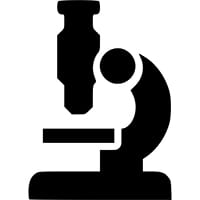Instruments
Three locations:
- Searle room 340F: Two 500 MHz and one automated 400 MHz NMR spectrometer
- Gordon Center for Integrative Sciences (GCIS) room E340: One 500 MHz and one automated 400 MHz NMR spectrometer
- Jones room 103: One X-Band EPR spectrometer
Searle NMR Lab
Daytime usage models:
- 500-2: Walkup & Intensive use
- 500-1: Walkup (< 20 min)
- 400-1: Automated routine 1D, 2D, heteronuclear
More details here:
https://chemnmrlab.uchicago.edu/instruments/searle/
GCIS NMR Lab
Daytime usage modes:
- 500-3: Walkup & Intensive use
- 400-2: Automated 1D, 2D, heteronuclear
More details here:
https://chemnmrlab.uchicago.edu/instruments/gcis/
EPR Lab
X-band / 10 GHz EPR spectrometer with 15K helium chiller
More details here:
https://chemnmrlab.uchicago.edu/instruments/epr/
What ARE these different usage modes?

Automated
“I put my samples in the robot so I can return to the bench while the spectrometer acquires high-quality routine data for me.”
Most routine NMR experiments can be conducted in fully automated fashion, leveraging a robotic sample changer and other hardware, plus sophisticated automation software. No reservations are necessary, and routine short-duration data are acquired on a first-come-first-served basis, amended by “night queue” acquisition for experiments longer than 20 minutes.
Our two automated spectrometers, one in Searle and one in GCIS, are interoperable – they have the same capabilities and parameter sets. Users certified for Level1 training automatically have privileges on both instruments and receive access to both labs.
Our goal is enabling researchers to try new experiments with which they have no prior experience. If they simply select an experiment with a typical sample, they should get good data with default parameters. In addition to supporting the most common 1H and 13C 1D and 2D experiments (DEPT135, COSY, NOESY, HSQC, HMBC), our automated systems are currently equipped to acquire 31P, 19F, 11B, 7Li, 29Si, 77Se, 75As, nuclei, each with the choice of 1H decoupling. Other nuclei between 109Ag and 31P frequencies may be added upon request or manager whim. Other experiments include T1 measurement (1H and 19F, more to be added), 2D 1H-15N HSQC and HMBC, and 2D HSQC-TOCSY.
Pulse sequences are curated so the most sophisticated reliable versions are the ones available. For example, users of the experiment labeled “HSQC” are simply provided the version with multiplicity editing, sensitivity improvement, and minimum phase cycle. Likewise, users of the experiment labeled “NOESY” enjoy the version with a swept-frequency RF pulse and gradient pulse in the mixing time to reduce zero-quantum coherence. The list of automation-supported experiments continues to grow as a function of user requests and manager initiative.
To maximize utility of long-term 1D 13C acquisition, we have a 3.5hr night-queue 13C parameter set. Current experiments include 1D 13C DEPT135, 2D COSY, 1H-13C HSQC (multiplicity-edited with sensitivity enhancement), and 2D 1H-13C HMBC (with suppression of one-bond correlations). More experiments will be added, and requests will be honored if implementable.

Walkup
“I walk up to the instrument and operate it manually to get a quick routine spectrum or two.”
Reservations are required, but for no more than 20 minutes. Only room temperature experiments are allowed. Quick 1D and 2D experiments, most with default parameters, are the most popular. Our facility provides a preferred array of standard parameter sets using sophisticated pulse sequences in order to yield the best data with least effort and maximum time efficiency.

Intensive
“I sit down with the instrument to manually run experiments that require extra attention and time.”
Examples include
• “Variable temperature” (VT), equilibrating samples to temperatures -150 to +150 °C.
• Diffusion measurement/DOSY, using NMR to gauge molecule/particle size
• 1D NOE, in which one manually chooses peaks to excite
• Solvent suppression, in which non-deuterated solvent peaks are selectively reduced
• Reaction monitoring*, where reactants are quickly mixed in the NMR tube and spectra are taken to follow reaction progress
• Titrations*, where small amounts of titrants are added to a sample to characterize binding or another property
*best done in the Searle lab, which has a support room with a bench and hood next to the instrument room.
